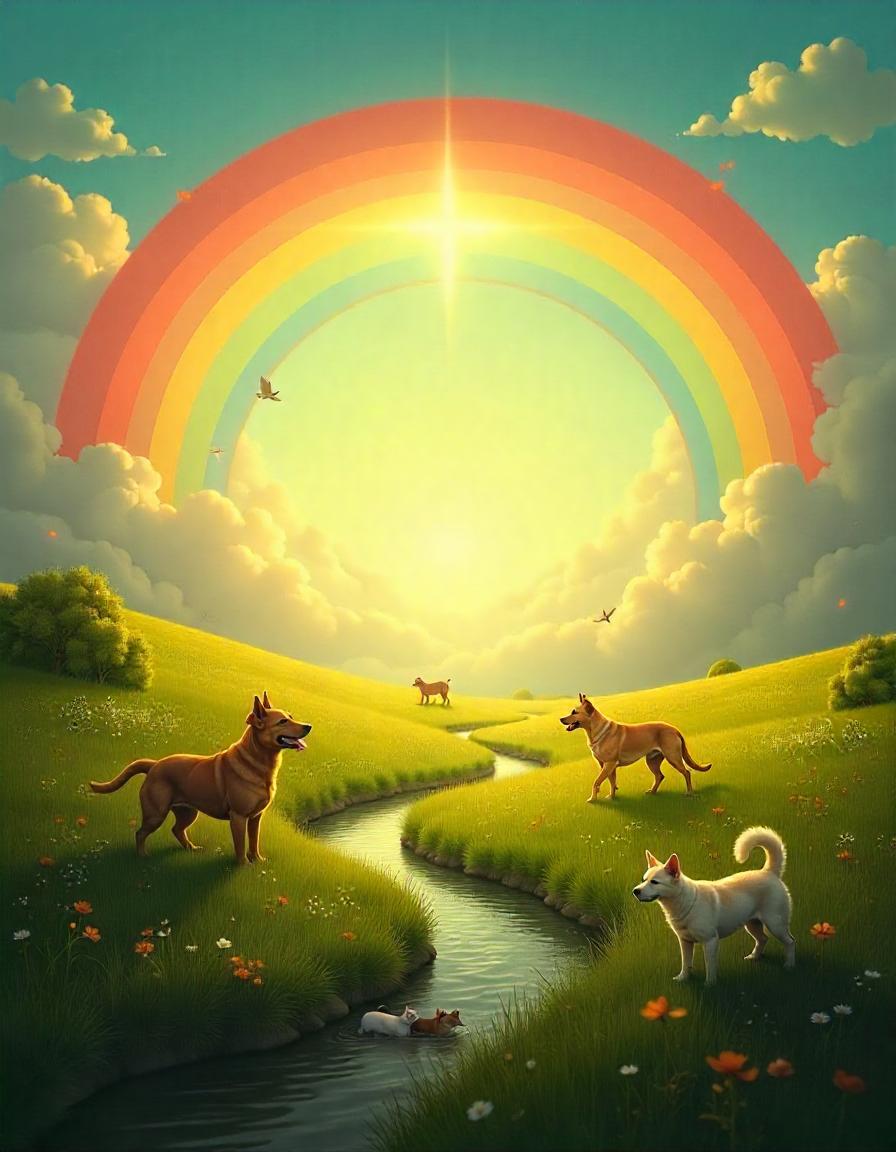EDUCATION
Rainbow Bridge Poem: A Tribute to Lost Pets

Losing a pet is one of the most emotionally painful experiences a person can endure. For many, pets are more than companions—they are family. They walk beside us through the chapters of our lives, providing unconditional love, comfort, and joy. When the time comes to say goodbye, it leaves a profound emptiness.
That’s where the Rainbow Bridge Poem comes in. A beautiful and touching piece of writing, this poem has brought solace to countless pet owners across the globe. It paints a vivid picture of hope, reunion, and healing—offering comfort when words often fail. But where did it come from? What does it really mean? And why does it resonate so deeply?
In this article, we’ll explore the origins, symbolism, and emotional depth of the Rainbow Bridge Poem, and how it continues to support those grieving the loss of their beloved animal companions.
What Is the Rainbow Bridge Poem?
The Rainbow Bridge Poem is a short, sentimental verse that describes a mythical place where pets go after they die—a lush, beautiful land where they are free from pain and suffering. There, they wait for their human companions until they can be reunited and cross the Rainbow Bridge together into the afterlife.
It’s not tied to any particular religion, which allows people from various belief systems to find comfort in its words. Though short, the poem holds immense power. Its vivid imagery and gentle tone provide a sense of peace and reassurance that love doesn’t end with death.
Who Wrote the Rainbow Bridge Poem?
While the exact origins of the poem are debated, it’s most often attributed to Paul C. Dahm, a grief counselor who is believed to have penned it in the 1980s. Other variations and similar poems have been written over the years, leading to some confusion about authorship.
Despite the ambiguity, what’s important is not who wrote it—but how many people it has touched. The poem has been shared in pet memorial cards, social media tributes, veterinary offices, and online pet communities. Its emotional reach is undeniable.
A Closer Look at the Rainbow Bridge Poem
Let’s briefly examine the heart of the poem and what makes it so meaningful.
Imagery and Emotion
The poem paints a place with:
-
Green meadows
-
Endless sunshine
-
Gentle rivers
-
A shining rainbow arched overhead
In this paradise, pets are whole again—running, playing, and free of pain. The emotional core centers around reunion: the moment when the pet sees its human companion and they walk together again, never to be parted.
Symbolism
-
The Rainbow: Hope, transition, connection between worlds.
-
The Bridge: Passage from one realm to another—a metaphor for entering eternal peace.
-
The Meadow: Healing space before the afterlife, where spirits are free and joyful.
This blend of natural beauty and spiritual metaphor is what makes the poem so powerful.
Why the Rainbow Bridge Poem Resonates So Deeply
Pet loss is often a unique kind of grief. It can be just as intense as losing a human loved one, yet it’s sometimes under-recognized in society. The Rainbow Bridge Poem acknowledges that loss. It validates the relationship we had with our pet, and more importantly, it speaks to the hope that we’ll see them again.
Some reasons why it connects so deeply:
-
It provides a visual story when the heart needs clarity.
-
It offers comfort during a time of sadness and guilt.
-
It gives people permission to grieve openly and honor their pet’s memory.
It turns sorrow into something beautiful.
How the Poem Is Used in Pet Grief and Healing
The Rainbow Bridge Poem has become a central piece in modern pet memorial culture. Here’s how it’s often used:
1. Pet Memorial Services
Veterinarians and pet crematoriums often include the poem on sympathy cards or urn plaques. It serves as a gentle closure to the process.
2. Social Media Tributes
Many pet parents share the poem online when saying goodbye to a furry friend. The community response is often filled with empathy and shared memories.
3. Pet Loss Support Groups
Both in-person and online grief groups reference the Rainbow Bridge as a source of collective healing.
4. Custom Keepsakes
People personalize the poem on:
-
Framed prints
-
Engraved stones
-
Jewelry
-
Photo books
These items become treasured reminders of the love once shared.
Rainbow Bridge Day: A Day of Remembrance
Did you know there’s a day dedicated to remembering pets who’ve crossed the Rainbow Bridge?
Rainbow Bridge Remembrance Day is observed annually on August 28th. Started by author Deborah Barnes in memory of her own cat, Mr. Jazz, the day encourages pet owners to share stories, photos, and memories of pets who have passed.
It’s a beautiful tradition that gives people a chance to reflect and celebrate their pet’s life in a supportive space.
Variations and Spin-Offs of the Rainbow Bridge Poem
Over the years, writers have created new versions of the poem tailored to different pets, situations, or spiritual beliefs. Some notable adaptations include:
-
For cats specifically
-
For dogs only
-
From the pet’s perspective
-
Versions including illness or euthanasia themes
These variations help individuals connect with the message more personally, showing the poem’s flexibility and emotional range.
Helping Children Understand Pet Loss with the Rainbow Bridge Poem
For children, the death of a pet may be their first experience with loss. The poem can be a gentle entry point into discussing difficult feelings. You can:
-
Read the poem aloud together
-
Draw or color a Rainbow Bridge scene
-
Write letters to the pet
-
Create a memory box with favorite toys or photos
It’s a great way to help kids express grief while feeling reassured that their pet is happy and waiting.
Rainbow Bridge in Popular Culture
The concept of the Rainbow Bridge has grown beyond the poem itself. You’ll now find it referenced in:
-
Pet sympathy cards and gifts
-
Animal rescue organizations
-
Online pet obituaries
-
Media and fiction stories
Its popularity reflects a collective need for closure and peace, particularly in a society that deeply cherishes animal companionship.
What the Rainbow Bridge Poem Teaches Us
The poem isn’t just about loss—it’s about love, reunion, and healing. It reminds us that:
-
Grieving is valid, no matter the species.
-
Bonds with pets are deep and meaningful.
-
Hope can coexist with sorrow.
-
Love never truly dies.
By offering a vision of joyful reunion, it helps us move forward without forgetting.
Also read: Used Toyota RAV4: A Smart SUV Choice
Conclusion
Whether you’ve recently lost a pet or are supporting someone who has, the Rainbow Bridge Poem offers a tender reminder that love transcends this life. It’s not just a poem—it’s a symbol of hope, a community touchstone, and a source of comfort during one of life’s most heart-wrenching moments.
So, the next time you gaze up at a rainbow, maybe you’ll smile. Because just beyond it, your beloved companion might be waiting—tail wagging, purring softly, or hopping playfully—until it’s your time to walk the bridge together.
FAQs
What is the Rainbow Bridge Poem?
It’s a poem that describes a peaceful, heavenly place where pets go after they pass away, waiting to be reunited with their owners someday.
Who wrote the Rainbow Bridge Poem?
The most commonly credited author is Paul C. Dahm, though other similar versions have appeared anonymously or from different writers.
Is the Rainbow Bridge Poem religious?
Not specifically. Its message is spiritual and comforting but doesn’t align with any one faith, making it accessible to all.
How can I use the poem to remember my pet?
You can share it on social media, include it in a memorial service, print it on keepsakes, or read it during quiet reflection.
Is Rainbow Bridge Day a real thing?
Yes! It’s observed on August 28th and is a day for remembering pets who have passed. Many people share photos and memories in tribute.

-

 EDUCATION3 months ago
EDUCATION3 months agoFree Cover Letter Generator: Build Job-Winning Letters in Minutes
-

 GUIDE3 months ago
GUIDE3 months agoBenefits of Online Personal Training for Fitness Success
-

 BUSINESS2 months ago
BUSINESS2 months agoGrow Your Audience with USA Instagram Followers
-

 TECH2 months ago
TECH2 months agoFreedom Forever Solar Reviews Explain How Conversational Intelligence Turns Customer Interactions into Insights